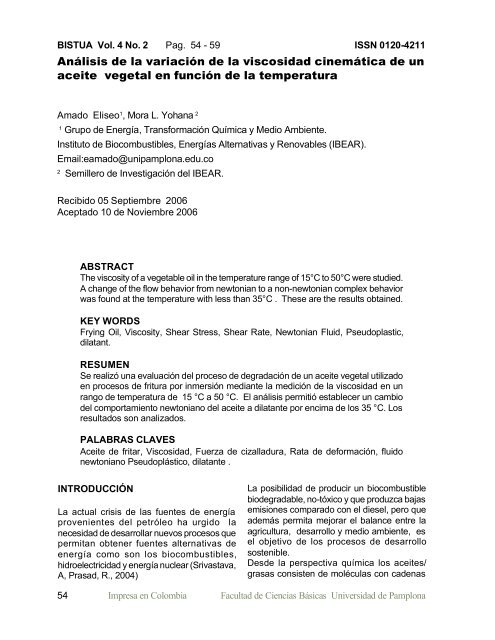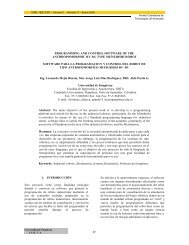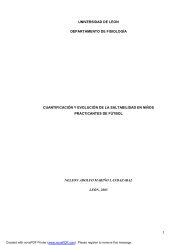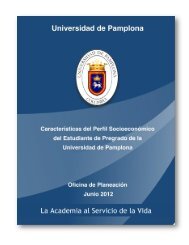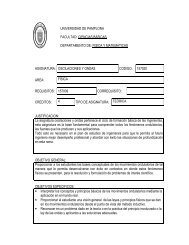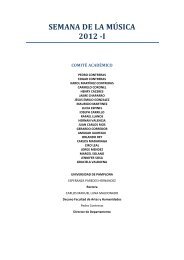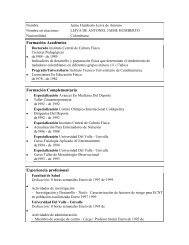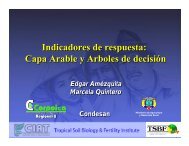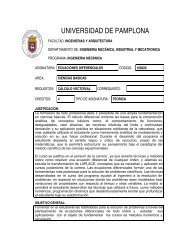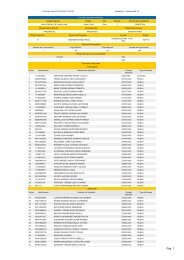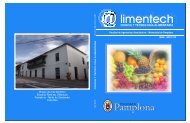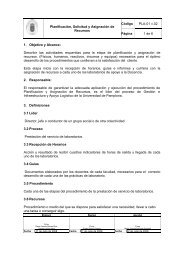Análisis de la variación de la viscosidad cinemática de un aceite ...
Análisis de la variación de la viscosidad cinemática de un aceite ...
Análisis de la variación de la viscosidad cinemática de un aceite ...
Create successful ePaper yourself
Turn your PDF publications into a flip-book with our unique Google optimized e-Paper software.
BISTUA Vol. 4 No. 2 Pag. 54 - 59<br />
INTRODUCCIÓN<br />
La actual crisis <strong>de</strong> <strong>la</strong>s fuentes <strong>de</strong> energía<br />
provenientes <strong>de</strong>l petróleo ha urgido <strong>la</strong><br />
necesidad <strong>de</strong> <strong>de</strong>sarrol<strong>la</strong>r nuevos procesos que<br />
permitan obtener fuentes alternativas <strong>de</strong><br />
energía como son los biocombustibles,<br />
hidroelectricidad y energía nuclear (Srivastava,<br />
A, Prasad, R., 2004)<br />
54<br />
ISSN 0120-4211<br />
<strong>Análisis</strong> <strong>de</strong> <strong>la</strong> <strong>variación</strong> <strong>de</strong> <strong>la</strong> <strong>viscosidad</strong> <strong>cinemática</strong> <strong>de</strong> <strong>un</strong><br />
<strong>aceite</strong> vegetal en f<strong>un</strong>ción <strong>de</strong> <strong>la</strong> temperatura<br />
Amado Eliseo 1 , Mora L. Yohana 2<br />
1 Grupo <strong>de</strong> Energía, Transformación Química y Medio Ambiente.<br />
Instituto <strong>de</strong> Biocombustibles, Energías Alternativas y Renovables (IBEAR).<br />
Email:eamado@<strong>un</strong>ipamplona.edu.co<br />
2 Semillero <strong>de</strong> Investigación <strong>de</strong>l IBEAR.<br />
Recibido 05 Septiembre 2006<br />
Aceptado 10 <strong>de</strong> Noviembre 2006<br />
ABSTRACT<br />
The viscosity of a vegetable oil in the temperature range of 15°C to 50°C were studied.<br />
A change of the flow behavior from newtonian to a non-newtonian complex behavior<br />
was fo<strong>un</strong>d at the temperature with less than 35°C . These are the results obtained.<br />
KEY WORDS<br />
Frying Oil, Viscosity, Shear Stress, Shear Rate, Newtonian Fluid, Pseudop<strong>la</strong>stic,<br />
di<strong>la</strong>tant.<br />
RESUMEN<br />
Se realizó <strong>un</strong>a evaluación <strong>de</strong>l proceso <strong>de</strong> <strong>de</strong>gradación <strong>de</strong> <strong>un</strong> <strong>aceite</strong> vegetal utilizado<br />
en procesos <strong>de</strong> fritura por inmersión mediante <strong>la</strong> medición <strong>de</strong> <strong>la</strong> <strong>viscosidad</strong> en <strong>un</strong><br />
rango <strong>de</strong> temperatura <strong>de</strong> 15 °C a 50 °C. El análisis permitió establecer <strong>un</strong> cambio<br />
<strong>de</strong>l comportamiento newtoniano <strong>de</strong>l <strong>aceite</strong> a di<strong>la</strong>tante por encima <strong>de</strong> los 35 °C. Los<br />
resultados son analizados.<br />
PALABRAS CLAVES<br />
Aceite <strong>de</strong> fritar, Viscosidad, Fuerza <strong>de</strong> cizal<strong>la</strong>dura, Rata <strong>de</strong> <strong>de</strong>formación, fluido<br />
newtoniano Pseudoplástico, di<strong>la</strong>tante .<br />
La posibilidad <strong>de</strong> producir <strong>un</strong> biocombustible<br />
bio<strong>de</strong>gradable, no-tóxico y que produzca bajas<br />
emisiones comparado con el diesel, pero que<br />
a<strong>de</strong>más permita mejorar el ba<strong>la</strong>nce entre <strong>la</strong><br />
agricultura, <strong>de</strong>sarrollo y medio ambiente, es<br />
el objetivo <strong>de</strong> los procesos <strong>de</strong> <strong>de</strong>sarrollo<br />
sostenible.<br />
Des<strong>de</strong> <strong>la</strong> perspectiva química los <strong>aceite</strong>s/<br />
grasas consisten <strong>de</strong> molécu<strong>la</strong>s con ca<strong>de</strong>nas<br />
Impresa en Colombia Facultad <strong>de</strong> Ciencias Básicas Universidad <strong>de</strong> Pamplona
ISSN 0120-4211<br />
<strong>la</strong>rgas <strong>de</strong> ácidos grasos <strong>un</strong>idos por en<strong>la</strong>ces ester<br />
a <strong>un</strong>a molécu<strong>la</strong> <strong>de</strong> glicerol. Estos ácidos grasos<br />
difieren entre sí por <strong>la</strong> longitud <strong>de</strong> ca<strong>de</strong>na, número,<br />
orientación y posición <strong>de</strong> los dobles en<strong>la</strong>ces. El<br />
biodiesel se obtiene por <strong>la</strong> transesterificación con<br />
alcoholes <strong>de</strong> bajo peso molecu<strong>la</strong>r o por<br />
esterificación <strong>de</strong> los ácidos grasos (Meher L.,<br />
Vidya D., Naik S., 2006)<br />
La investigación <strong>de</strong> los <strong>aceite</strong>s vegetales ha<br />
cobrado gran interés por <strong>la</strong> posibilidad <strong>de</strong><br />
<strong>de</strong>sarrol<strong>la</strong>r tecnologías que permitan su<br />
transformación en Biodiesel y <strong>de</strong>rivados<br />
(Canoira, L et.al., 2007, Felizardo, P. et.al., 2006,<br />
Le<strong>un</strong>g, D. Guo, Y, 2006, Marchetti, J. et.al., 2007,<br />
P, Pugazhvadivu, M. Jeyachandran, K, 2005,<br />
Zheng, S, 2006).<br />
El proceso <strong>de</strong> fritura por inmersión es<br />
ampliamente usado en <strong>la</strong> preparación <strong>de</strong><br />
alimentos. Las altas temperaturas que alcanzan<br />
los <strong>aceite</strong>s durante el proceso produce <strong>un</strong>a<br />
compleja serie <strong>de</strong> reacciones que resultan en <strong>la</strong><br />
oxidación y polimerización <strong>de</strong>l <strong>aceite</strong> (Silva, M.,<br />
Singh, R., 2004). A<strong>de</strong>más los residuos <strong>de</strong> <strong>la</strong><br />
comida, que frecuentemente alcanzan valores<br />
a 25% <strong>de</strong> compuestos po<strong>la</strong>res, y su respectiva<br />
<strong>de</strong>gradación, también afectan <strong>la</strong> calidad <strong>de</strong>l<br />
<strong>aceite</strong>. Una <strong>de</strong> <strong>la</strong>s propieda<strong>de</strong>s directamente<br />
afectadas por los compuestos po<strong>la</strong>res y los<br />
procesos <strong>de</strong> polimerización es La <strong>viscosidad</strong><br />
(Lacey, R. Payne, F., 1994). La importancia <strong>de</strong>l<br />
estudio <strong>de</strong> <strong>la</strong> <strong>viscosidad</strong> bajo diferentes<br />
condiciones radica en que permite <strong>de</strong>terminar <strong>la</strong><br />
viabilidad <strong>de</strong> uso <strong>de</strong> <strong>un</strong> <strong>aceite</strong> como combustible<br />
o lubricante (Mangesh, G. et.al., 2007, Fernando,<br />
S. et.al., 2007, George, S. et.al., 2007).<br />
La atomización <strong>de</strong>l combustible es afectada por<br />
factores como <strong>de</strong>nsidad, <strong>viscosidad</strong> y tensión<br />
superficial (Knothe, G. 2005). Distintos métodos<br />
y mo<strong>de</strong>los se han <strong>de</strong>sarrol<strong>la</strong>do para pre<strong>de</strong>cir <strong>la</strong><br />
<strong>viscosidad</strong> <strong>de</strong> <strong>un</strong> tipo específico <strong>de</strong> <strong>aceite</strong><br />
combustible puro o <strong>de</strong> <strong>la</strong>s mezc<strong>la</strong>s con diesel<br />
(Ya<strong>un</strong>, W. et.al.,2005). Igualmente el<br />
comportamiento reológico <strong>de</strong> mezc<strong>la</strong>s <strong>de</strong> <strong>aceite</strong><br />
<strong>de</strong> soya y diesel se ha <strong>de</strong>terminado <strong>de</strong>s<strong>de</strong> el<br />
p<strong>un</strong>to cero <strong>de</strong> temperatura hasta 373 K (Tat, M,<br />
Van Garpen. 1999)<br />
El presente trabajo se presenta <strong>la</strong> evaluación <strong>de</strong><br />
<strong>la</strong> <strong>variación</strong> <strong>de</strong>l comportamiento reológico <strong>de</strong> <strong>un</strong><br />
<strong>aceite</strong> <strong>de</strong> fritura en el rango <strong>de</strong> temperatura <strong>de</strong><br />
<strong>de</strong> 15 °C a 50 °C en el marco <strong>de</strong>l estudio <strong>de</strong><br />
equilibrios ternario y cuaternario <strong>de</strong> mezc<strong>la</strong>s <strong>de</strong><br />
<strong>aceite</strong> y agua.<br />
MATERIALES Y METODOS<br />
Las medidas <strong>de</strong> <strong>viscosidad</strong> se realizaron en<br />
viscosímetro <strong>de</strong> baja BROOKFIELD, mo<strong>de</strong>lo<br />
RVDV-E. Se utilizó <strong>un</strong>a mezc<strong>la</strong> estándar <strong>de</strong><br />
<strong>aceite</strong> <strong>de</strong> girasol, algodón, soya, ajonjolí, maní y<br />
oleína <strong>de</strong> palma. Las medidas <strong>de</strong> RPM ( 0.5, 0.6,<br />
1, 1.5, 2, 2.5, 3, 4, 5, 6, 10, 12, 20, 30, 50, 60) se<br />
realizaron por ascenso y <strong>de</strong>scenso. Se utilizó<br />
<strong>un</strong> usillo No.1. El sistema se termostato por 12<br />
horas y luego <strong>la</strong>s medidas se hicieron por<br />
triplicado.<br />
Las siguientes ecuaciones se utilizaron para<br />
el usillo cilíndrico:<br />
2 2<br />
C b<br />
= 2<br />
X R 2 − R<br />
(1)<br />
2<br />
C b<br />
=<br />
2<br />
Facultad <strong>de</strong> Ciencias Básicas Universidad <strong>de</strong> Pamplona Impresa en Colombia<br />
2<br />
M<br />
R<br />
b 2<br />
R<br />
L<br />
R<br />
BISTUA Vol. 4 No. 2<br />
(2)<br />
= (3)<br />
Don<strong>de</strong> :<br />
g : Rata <strong>de</strong> <strong>de</strong>formación (s-1)<br />
t : Fuerza <strong>de</strong> cizal<strong>la</strong>dura (dinas/cm2)<br />
h : <strong>viscosidad</strong> (poise)<br />
w : velocidad angu<strong>la</strong>r <strong>de</strong>l usillo (rad/s)<br />
Rc: Radio <strong>de</strong>l vaso (cm)<br />
Rb : Radio <strong>de</strong>l usillo (cm)<br />
X : Radio al cual <strong>la</strong> fuerza <strong>de</strong> cizal<strong>la</strong>dura<br />
es calcu<strong>la</strong>da<br />
M : torque medido por el equipo<br />
L : Longitud efectiva <strong>de</strong>l usillo<br />
RESULTADOS Y DISCUSION<br />
En Las tab<strong>la</strong>s 1 -3 se presentan los datos<br />
correspondientes a porcentaje <strong>de</strong> torsión, rata<br />
55
BISTUA Vol. 4 No. 2<br />
56<br />
Tab<strong>la</strong> 1. Datos <strong>de</strong> <strong>viscosidad</strong> <strong>de</strong>l <strong>aceite</strong> vegetal a 15 °C, 20 °C y 25 °C.<br />
RPM 15 °C 20 °C 25 °C<br />
γ % T τ η % T τ η % T τ η<br />
s -1<br />
dina/cm 2<br />
Poise dina/cm 2<br />
Poise dina/cm 2<br />
Poise<br />
Tab<strong>la</strong> 2. Datos <strong>de</strong> <strong>viscosidad</strong> <strong>de</strong>l <strong>aceite</strong> vegetal a 30 °C, 35 °C y 40 °C .<br />
RPM 30 °C 35 °C 40 °C<br />
γ % T τ η % T τ η % T τ η<br />
s -1<br />
dina/cm 2<br />
Poise dina/cm 2<br />
Poise dina/cm 2<br />
ISSN 0120-4211<br />
0,5 1,1111 1,4 0,03086 0,02777 1,0 0,02094 0,01884 0,7 0,014326 0,012893<br />
0,6 1,3334 1,6 0,03526 0,02645 1,0 0,02094 0,01570 0,8 0,016529 0,012397<br />
1 2,2223 1,9 0,04187 0,01884 1,3 0,02755 0,01240 1,2 0,025345 0,011405<br />
1,5 3,3334 2,5 0,05400 0,01620 1,8 0,03967 0,01190 1,6 0,035263 0,010579<br />
2 4,4445 3,2 0,06942 0,01562 2,3 0,05069 0,01141 2,0 0,044079 0,009918<br />
2,5 5,5557 3,8 0,08375 0,01507 2,8 0,06171 0,01111 2,4 0,051792 0,009322<br />
3 6,6668 4,4 0,09697 0,01455 3,3 0,07163 0,01074 2,7 0,058404 0,008760<br />
4 8,8890 5,7 0,12452 0,01401 4,2 0,09146 0,01029 3,4 0,073832 0,008306<br />
5 11,1113 6,9 0,15097 0,01359 5,0 0,11020 0,00992 4,1 0,089259 0,008033<br />
6 13,3336 8,1 0,17742 0,01331 5,8 0,12673 0,00950 4,8 0,104687 0,007851<br />
10 22,2226 13,3 0,29312 0,01319 9,5 0,20937 0,00942 7,7 0,169703 0,007636<br />
12 26,6671 16,0 0,35153 0,01318 11,5 0,25235 0,00946 9,3 0,203864 0,007645<br />
20 44,4452 26,5 0,58294 0,01312 19,2 0,42315 0,00952 15,6 0,342711 0,007711<br />
30 66,6678 39,8 0,87716 0,01316 29,1 0,64024 0,00960 23,5 0,517924 0,007769<br />
50 111,1131 66,3 1,46121 0,01315 48,8 1,07442 0,00967 39,7 0,874961 0,007875<br />
60 133,3357 79,7 1,75653 0,01317 58,6 1,29150 0,00969 47,9 1,055683 0,007917<br />
0,5 1,1111 0,8 0,017631 0,015868 0,5 0,01102 0,009918 0,5 0,01102 0,00992<br />
0,6 1,3334 0,9 0,019835 0,014876 0,6 0,013224 0,009918 0,6 0,012122 0,00909<br />
1 2,2223 1,1 0,024243 0,010909 0,9 0,019835 0,008926 0,8 0,017631 0,00793<br />
1,5 3,3334 1,4 0,033059 0,009918 1,2 0,026447 0,007934 1,1 0,024243 0,00727<br />
2 4,4445 1,8 0,039671 0,008926 1,6 0,034161 0,007686 1,4 0,029753 0,00669<br />
2,5 5,5557 2,1 0,046283 0,008331 1,8 0,039671 0,007141 1,6 0,035263 0,00635<br />
3 6,6668 2,4 0,052894 0,007934 2 0,044079 0,006612 1,9 0,040773 0,00612<br />
4 8,889 3 0,066118 0,007438 2,5 0,055098 0,006198 2,3 0,049588 0,00558<br />
5 11,1113 3,6 0,079342 0,007141 3 0,066118 0,005951 2,5 0,053996 0,00486<br />
6 13,3336 4,2 0,092565 0,006942 3,5 0,077138 0,005785 2,7 0,059506 0,00446<br />
10 22,2226 6,7 0,147663 0,006645 5,6 0,12342 0,005554 4,3 0,094769 0,00427<br />
12 26,6671 8 0,176315 0,006612 6,6 0,145459 0,005455 5,3 0,115706 0,00434<br />
20 44,4452 13,7 0,301939 0,006793 11,1 0,244636 0,005504 9,5 0,208272 0,00469<br />
30 66,6678 20,6 0,45401 0,006810 16,9 0,372464 0,005587 14 0,317366 0,00476<br />
50 111,1131 34,8 0,766968 0,006903 28,7 0,632528 0,005693 25 0,541065 0,00487<br />
60 133,3357 21 0,923447 0,006926 34,7 0,764764 0,005736 30 0,654568 0,00491<br />
<strong>de</strong> <strong>de</strong>formación, fuerza <strong>de</strong> cizal<strong>la</strong>dura y<br />
<strong>viscosidad</strong> a <strong>la</strong>s distintas temperaturas.<br />
En <strong>la</strong> Figura 1 se observa el comportamiento<br />
newtoniano <strong>de</strong>l <strong>aceite</strong> a <strong>la</strong>s distintas<br />
temperaturas. Sin embargo, para <strong>la</strong>s<br />
Impresa en Colombia Facultad <strong>de</strong> Ciencias Básicas Universidad <strong>de</strong> Pamplona<br />
Poise<br />
temperaturas mayores <strong>de</strong> 35 C, el<br />
comportamiento se hace complejo como se<br />
observa en <strong>la</strong> Figura 2, don<strong>de</strong> <strong>la</strong> <strong>de</strong>formación <strong>de</strong><br />
<strong>la</strong>s curvas sugiere <strong>un</strong> comportamiento nonewtoniano.
ISSN 0120-4211<br />
transformación directa en biodiesel. Esto<br />
implicará <strong>de</strong>sarrol<strong>la</strong>r mezc<strong>la</strong>s con distintos<br />
<strong>aceite</strong>s para lograr <strong>la</strong> disminución <strong>de</strong> <strong>la</strong><br />
<strong>viscosidad</strong>.<br />
La mezc<strong>la</strong> estándar <strong>de</strong> <strong>aceite</strong> <strong>de</strong> girasol,<br />
algodón, soya, ajonjolí, maní y oleína <strong>de</strong> palma<br />
presenta <strong>un</strong> comportamiento i<strong>de</strong>al newtoniano<br />
a temperatura ambiente. Sin embargo, <strong>un</strong>a vez<br />
<strong>la</strong> temperatura aumenta su comportamiento se<br />
hace complejo. A temperaturas mayores <strong>de</strong> 35<br />
BIBLIOGRAFIA<br />
Amado, E., Perea, J. López. A. Caracterización termoanalítica <strong>de</strong> semil<strong>la</strong>s <strong>de</strong> Ricinus<br />
cumm<strong>un</strong>is varieda<strong>de</strong>s mamona b<strong>la</strong>nca, mamona negra y Silvestre: análisis <strong>de</strong> <strong>la</strong>s<br />
propieda<strong>de</strong>s reológicas <strong>de</strong>l biodiesel. Bistua. 2006, 4(1):15-20.<br />
Canoira, L Alcántara, R. Torcal, S. Tsiouvaras, N. Lois, E. Korres, D. Nitration of bioidiesel<br />
of waste oil: nitrated biodiesel as a cetane number enhancer. Fuel. 2007 (86):965-971.<br />
Felizardo, P. Correia, N. Raposo, I. Men<strong>de</strong>s, J. Berkemier, R. Bordado, J. Production of<br />
biodiesel from waste frying oils. Waste Management. 2006 (26): 487-494.<br />
Fernando, S. Karra, P. Hernan<strong>de</strong>z, R. Kumar, S. Effect of incompletely converted soybean<br />
oil on biodiesel quality. Energy, 2007 (32):844-851.<br />
George, S. Bal<strong>la</strong>, S. Gautam, V. Gautam, M. Effect of diesel soot on lubricant oil viscosity.<br />
Tribology International. 2007 (40):809-818.<br />
Knothe, G. Depen<strong>de</strong>nce of biodiesel fuel properties on the structure of fatty acid alkyl esters.<br />
Fuel Process Technol. 2005 (86): 1059-1070.<br />
Lacey, R. Payne, F. Ultrasonic velocity in used corn oil as a measure of oil quality.<br />
Transactions of the ASAE. 1994 (37): 1583-1589.<br />
Le<strong>un</strong>g, D. Guo, Y. Transesterification of neat and used frying oil: Optimization for biodiesel<br />
production. Fuel Processing Technology. 2006 (87): 883-890.<br />
Mangesh, G. Kulkarni, A. Da<strong>la</strong>i, A. Bakhshi, N. Transesterification of cano<strong>la</strong> oil in mixed<br />
methanol/ethanol system and use of esters as lubricity additive. Bioresourse<br />
Technology.2007 (98):2027-2033.<br />
Marchetti, J. Miguel, V. Errazu, A. Heterogeneous esterification of oil with high amo<strong>un</strong>t of<br />
free fatty acids. Fuel. 2007 (86): 906-910.<br />
Meher L., Vidya D., Naik S. Technical aspects of biodiesel production by transesterification<br />
- review. Renewable and Sustainable energy review. 2006: 248-268.<br />
Pugazhvadivu, M. Jeyachandran, K. Investigations on the performance and exhaust<br />
emissions of a diesel engine using preheated waste frying oil as fuel. Renewable Energy.<br />
2005, 30 (14):2189-2202.<br />
Silva, M., Singh, R. Viscosity and surface tension of corn oil at frying temperatures. J. Food<br />
Processing and Preservation. 1995 (19):259-270.<br />
Srivastava, A, Prasad. R. Triglyceri<strong>de</strong>s-based diesel fuels. Renev.Sustain.Energy Rev. 2004<br />
(4):111-133.<br />
Tat, M, Van Garpen. The Kinematic viscosity of biodiesel and its blends with diesel fuel.<br />
JAOCS. 1999, 76 (12):1511-1513.<br />
Ya<strong>un</strong>, W. Hansen, A. Zhang, Q. Tan, Z. Temperature <strong>de</strong>pen<strong>de</strong>nt kinematic viscosity of<br />
selected biodiesel fuels and blends with diesel fuel. JAOCS. 2005, 82 (3)195-199.<br />
Zheng, S. Kates, M. Dube, M. Mclean, D. Biomass and Bioenergy. Acid catalized production<br />
of biodiesel from waste frying oil. 2006 (30):267-272.<br />
Facultad <strong>de</strong> Ciencias Básicas Universidad <strong>de</strong> Pamplona Impresa en Colombia<br />
BISTUA Vol. 4 No. 2<br />
ºC se observa el fenómeno <strong>de</strong> fluido no<br />
newtoniano di<strong>la</strong>tante para valores menores <strong>de</strong><br />
14 s -1 <strong>de</strong> rata <strong>de</strong> <strong>de</strong>formación <strong>de</strong>bido<br />
posiblemente a <strong>la</strong> presencia <strong>de</strong> sólidos<br />
<strong>de</strong>flocu<strong>la</strong>dos causados por <strong>la</strong> <strong>de</strong>gradación <strong>de</strong>l<br />
<strong>aceite</strong>.<br />
AGRADECIMIENTOS<br />
El autor agra<strong>de</strong>ce a <strong>la</strong> Maestría en Alimentos<br />
<strong>de</strong> <strong>la</strong> Universidad <strong>de</strong> Pamplona por el prèstamo<br />
<strong>de</strong> los equipos.<br />
59


